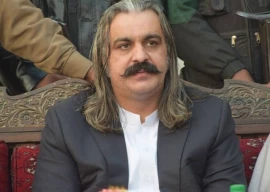
The federal Cabinet on Wednesday approved the budget strategy paper – which forms the basis of the next year’s budget – which focuses on macroeconomic stability, and significantly cuts down subsidies during the election year.
For fiscal 2012-13, the government has estimated expenditures of Rs2.738 trillion, against gross income of Rs3.033 trillion. Of this income, however, Rs1.421 trillion will be transferred to provinces, leaving the federal government with net income of Rs1.612 trillion, and a deficit of Rs1.125 trillion.
The budget deficit, therefore, is expected to be 4.7% of the national economy, which is estimated to stand at Rs24 trillion next year. It will be bridged by borrowing from domestic and external sources.
The federal government, however, hopes that the four provinces would be able to save Rs110 billion from their incomes and this would help reduce the overall budget deficit to 4.2%, or Rs1,015 billion, said Special Secretary Finance Rana Assad Amin.
The premier was briefed that the federal government is left with only 30% of its income while the rest is transferred to the four provinces, Azad Jammu and Kashmir and Gilgit-Baltistan governments.
Of the expenditure, Rs2.3 trillion have been proposed for non-development expenses, Rs350 billion for development expenses, and Rs87 billion for other development expenditures.
The economy is expected to grow by 4.5%, inflation estimated to be at 9.5% and debt-to-GDP ratio to be reduced by 3% in the next fiscal.
The proposed overall size of the budget is only Rs170 billion, or 6.6%, higher than the revised budget of the current fiscal.
Government’s priorities
Secretary Finance Wajid Rana briefed the Cabinet that increasing oil prices in the international market, slowdown of foreign loans, bleeding public sector enterprises and power sector are the biggest risks to the next year’s budget.
The premier directed the finance ministry to prioritise minimising of load-shedding in the next year. Information Minister Dr Firdous Ashiq Awan added that if the government failed to curtail the power crisis, the ruling Pakistan Peoples Party will have a hard time at the polls.
The budget strategy paper is subject to changes proposed by Cabinet members, Amin said.
Federal ministers have recommended increasing subsidies, providing ‘relief’ to the agriculture sector by reducing taxes on inputs, and focusing on youth and small and medium enterprises in the country, he said, adding that the premier has called a special Cabinet meeting to finalise the budget.
He added that federal excise duties will be reduced further next year and non-development expenditures will be frozen.
Distortions in the salaries of civil and military employees will be removed and there is a possibility of revising the basic pay scales, he added.
Proposed expenses
The Cabinet approved indicative budget ceilings and fixed Rs545 billion for defense, an increase of 10.1% over the current year’s allocation.
The provinces will get Rs1.421 trillion as their share in the federal divisible pool, Rs217 billion or 18% higher than the current year.
An amount of Rs120 billion has been proposed for subsidies, which is Rs70 billion less than the budgeted subsidies for the current fiscal year.
For running the federal government, Rs227 billion have been earmarked by the Cabinet, which is almost at current year’s level.
A lion’s share of Rs932 billion has been proposed for debt servicing, which is Rs137 billion higher than current year’s revised allocation.
Expected income
The federal government has assessed its gross income at Rs3.033 trillion including tax revenue of Rs2.338 trillion and non-tax revenue of Rs552 billion.
The tax target for Federal Board of Revenue is Rs386 billion, or 19.8%, higher than current year’s target, but is subject to change, Amin said. Rs143 billion is expected to be raked in on account of petroleum levy and gas surcharges, which is Rs26 billion higher than the current year’s revised target.
Published in The Express Tribune, April 12th, 2012.
COMMENTS (4)
Comments are moderated and generally will be posted if they are on-topic and not abusive.
For more information, please see our Comments FAQ







1732776427-0/Express-Tribune-(1)1732776427-0-270x192.webp)

1732776989-0/Untitled-design-(71)1732776989-0-270x192.webp)
1732772730-0/BeFunk_§_]__-(63)1732772730-0.jpg)






Dedicated to all army-bashers.................
Share of army in total budget of Pakistan: (0.545 trillion)/(2.738 trillion)*100 = 19.90504 %
Now where are those so called analysts who lie openly on national media by quoting the figure of 60 to 70 percent.
This is a good report Shahbaz but I don't believe the numbers being churned out. So I think your declaring victory of financial stability over macroeconomic populism is a bit premature.
Wonder what is the electricity bill for that hall.
The numbers have no significance when economy is managed on whims.it is beyond comprehension how the deficit will be met. FY13 is election year and budget will be driven by political motives All efforts will yield no results unless 1) budget deficit is contained by containing extravaganzas, 2) power theft is contained and 3) losses of public sector enterprises controlled.The government is still relying on foreign inflows particularly payments under CSF. Little is being done to catch the big tax evaders.Average person can bear no more burden.